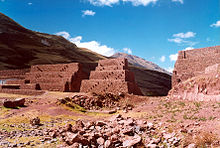 View of Rumicolca | |
| Location | Lucre District, Quispicanchi Province, Cusco Region, Peru |
|---|---|
| Region | Andes |
| Coordinates | 13°37′05″S71°42′26″W / 13.61806°S 71.70722°W |
Rumicolca [1] [2] (possibly from Quechua rumi stone, qullqa, qulqa deposit, storehouse) [3] is an archaeological site in Peru. It is located in the Cusco Region, Quispicanchi Province, Lucre District. Rumicolca is situated near the archaeological sites Chuqi Pukyu and Pikillaqta, east of Lake Huacarpay.

